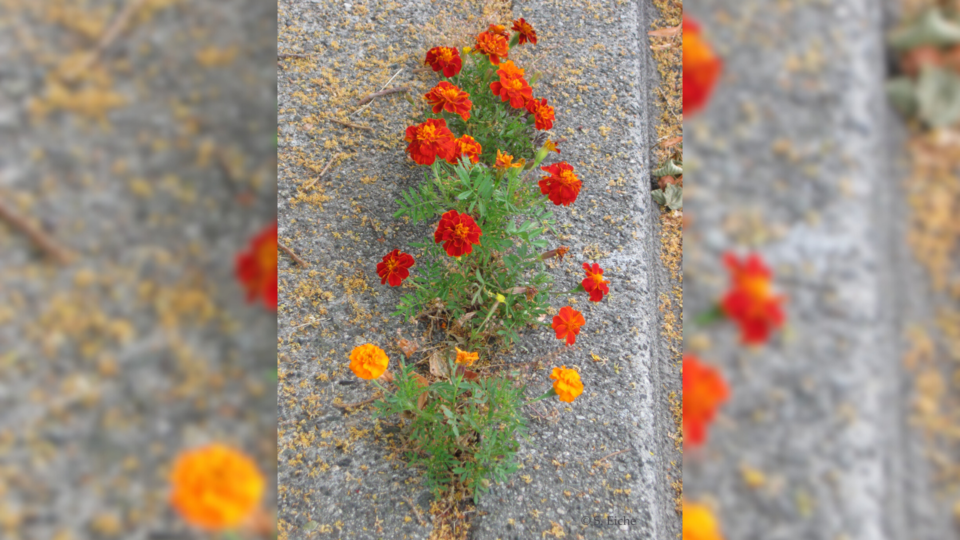For years all I’d see along the curb of streets was litter – those paper bits and plastic containers that tend to fly out of garbage bins on collection day and, when the pandemic was in full swing, discarded face masks, tossed aside by careless and thoughtless people. Lodged in the crack between the curb and sidewalk I’d find cigarette butts, but also dandelions, most welcome for the early flowers they produce. Less welcome was the quackgrass, which has few redeeming features. My efforts to pull it out were in vain because quackgrass is as uncontrollable as a certain former American president.
Then, this past spring, my sister-in-law sent me the link to a story about kindergarten children experimenting with seeds dropped along the edges of a sidewalk. The flowers they seeded were marigolds, and they grew vigorously and abundantly, far beyond anyone’s expectation. I was inspired to try to achieve a similar effect and sowed marigolds in the crack of the curb in front of my yard.
It involved clearing out some of the detritus that had fallen into the crack and then adding soil – I used ordinary sandy soil that I transferred from another part of the yard. At the beginning the challenge was to find marigold seeds. It was the end of April, rather a late date to start, and the inexpensive brands – carried by Rona and Canadian Tire, for instance – were completely sold out. Eventually, I got enough seeds for a row of flowers stretching several feet. There was sufficient rain to assure germination, and all I had to do was hope the birds wouldn’t poke around too much in the cracks, looking for scrumptious bugs.
The marigold project reminded me of another project I’d read about – how rebel botanists, above all in France and the UK, were inscribing pavements and walls with the names of so-called weeds that were growing in those spots. It was an unexpectedly great success. One of the French botanists involved told a reporter he “wanted to raise awareness of the presence, knowledge and respect of these wild plants on sidewalks. People who had never taken the time to observe these plants now tell me their view has changed.”
In May 2020 I decided to try something similar in my yard along the border with the sidewalk, where several plants – mainly woad and wild Italian arugula – had sprung up spontaneously. I wrote their names on signs and stuck them into the ground. The rebel-botanist-project made me search for other wild plants growing in the forgotten corners of the yard. I discovered some that pollinators delight in. Time and again I’m reminded to look closely at what grows around me and not to ‘tidy up’ according to a standard that’s based on the values of an artificial, conventional aesthetic rather than on nature.
That’s one of my main reasons for sowing marigolds in the crack of the curb – to try to persuade people to see the plants growing underfoot, as it were. Little children and older adults are sufficiently curious to let themselves be tempted by the sight of nature’s wonders. I observe their behaviour almost daily as they walk along the sidewalk in front of my yard. It’s the generation between childhood and adulthood that presents the greatest challenge. In their teens and early twenties, nearly always wearing hoodies, they shuffle along the sidewalk with heads bent down and eyes fixed on the small hand-held rectangle that contains their world. They appear indifferent to whatever else is occupying the space through which they traipse. If the marigolds, or any of the wild plants along the sidewalk, could make their glance slide off the smartphone screen for even a second, I’d feel amply rewarded.
Sabine Eiche is a local writer and art historian with a PhD from Princeton University. She is passionately involved in preserving the environment and protecting nature. Her columns deal with a broad range of topics and often include the history (etymology) of words in order to shed extra light on the subject.

.jpg;w=120;h=80;mode=crop)

